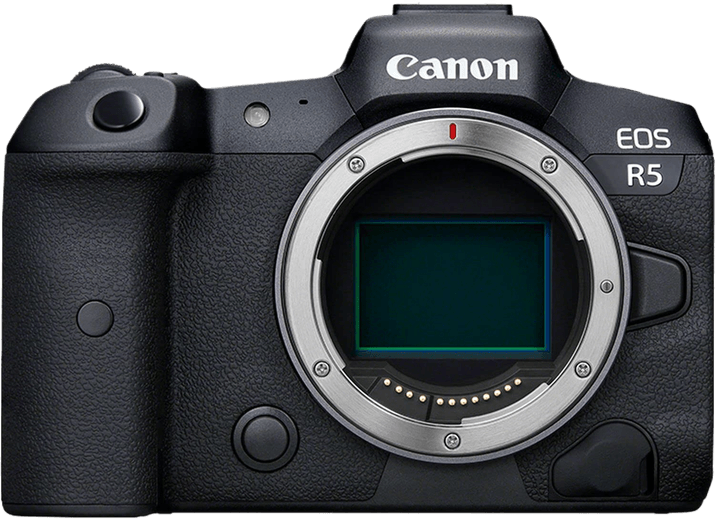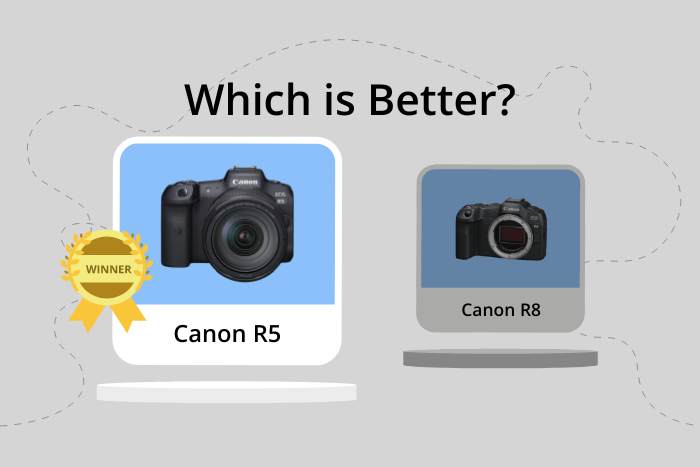Canon EOS R5 vs EOS R8 Comparison
Canon EOS R5

Canon EOS R8

The Canon EOS R5 outperforms the Canon EOS R8 with a score of 86/100 compared to 76/100. Both cameras share some similarities, being mirrorless and released within a few years of each other. However, the EOS R5, released in 2020, boasts a higher launch price of $4499, while the EOS R8, released in 2023, is more affordable at $1499.
The EOS R5’s higher score reflects its superior performance. It has a larger size, measuring 138 x 98 x 88mm, and a heavier weight of 680g (1.50lbs). This suggests a more robust build and potentially better features.
On the other hand, the EOS R8’s smaller size (133 x 86 x 70mm) and lighter weight (461g / 1.02lbs) make it more portable and convenient for on-the-go photography. Its lower price also makes it more accessible to a wider range of users.
Taking all these factors into account, the Canon EOS R5 is the better camera in terms of performance, while the EOS R8 offers a more budget-friendly and portable option.
Canon EOS R5 vs EOS R8 Overview and Optics
The Canon EOS R5 outperforms the Canon EOS R8 in optics with a score of 88/100, an 11-point difference from the R8’s 77/100. Both cameras share several specifications, such as a CMOS sensor, a Digic X processor, a full-frame sensor size, and a Canon RF lens mount. Despite these similarities, the R5 takes the lead in certain aspects, while the R8 excels in others.
The R5 boasts a higher megapixel count of 45 compared to the R8’s 24, allowing for more detailed and sharper images. Furthermore, the R5’s DXOMARK score for the sensor is 95, slightly higher than the R8’s 94, indicating better overall image quality. A significant advantage the R5 has over the R8 is its built-in image stabilization, which helps in reducing camera shake and capturing sharper images in low light conditions or with slower shutter speeds.
On the other hand, the R8 surpasses the R5 in shooting speed, offering a remarkable 40 frames per second compared to the R5’s 20. This makes the R8 more suitable for capturing fast-moving subjects and action photography. However, the R8 lacks image stabilization, which may limit its performance in certain situations.
Taking these factors into account, the Canon EOS R5 emerges as the winner in optics, providing better image quality, higher resolution, and image stabilization. The Canon EOS R8, while offering an impressive shooting speed, falls short in other aspects, making it a less versatile choice for photographers seeking exceptional optics performance.
Canon EOS R5 vs EOS R8 Video Performance
The Canon EOS R5 outperforms the Canon EOS R8 in video capabilities with a score of 100/100, compared to the R8’s score of 91/100. Both cameras share some common features, such as built-in time-lapse functionality, which is useful for creating stunning time-lapse videos.
The EOS R5 is superior in video quality, offering a maximum video resolution of 8K (8192 x 4320), while the EOS R8’s maximum resolution is 4K (3840 x 2160). This higher resolution allows for more detailed and sharp footage, making the R5 a better choice for professional videographers and filmmakers.
In addition to its higher resolution, the R5 also has a maximum video frame rate of 120fps, which is suitable for capturing fast-moving subjects and creating smooth slow-motion footage. However, the R8 has a faster maximum frame rate of 180fps, which can be advantageous for specific slow-motion applications or capturing extremely fast action.
Despite the R8’s higher frame rate, the R5’s superior video resolution and overall score make it the better choice for most videography needs. The R5 delivers higher quality footage, which can be essential for professional projects and high-resolution displays.
On the other hand, the R8 may be more suitable for those who prioritize a higher frame rate for specific applications, such as extreme sports or wildlife videography. Both cameras are capable of producing high-quality videos, but the R5’s 8K resolution and top score make it the preferred choice for videographers seeking exceptional video quality.
Canon EOS R5 vs EOS R8 Features and Benefits
The Canon EOS R5 wins the features comparison with a score of 87/100, while the Canon EOS R8 scores 85/100. Both cameras share several specifications, such as a touchscreen, flip screen, and the absence of GPS. Additionally, both cameras have WIFI and Bluetooth capabilities.
The R5 outperforms the R8 in terms of screen size and resolution. With a 3.2-inch screen and a resolution of 2,100,000 dots, the R5 provides users with a larger and sharper display. This advantage allows for better image preview and easier menu navigation. The R8, on the other hand, has a 3-inch screen with a resolution of 1,620,000 dots. Although smaller and less sharp, it still offers a decent display for users.
In comparison, the R8 has no notable advantages over the R5 in terms of features, as both cameras have almost identical specifications. The slight difference in their scores suggests that the R5 has a slight edge in overall performance and user experience.
Considering the features, the Canon EOS R5 is the superior camera, offering a larger and higher-resolution screen. While the R8 still provides a good user experience, it falls short in comparison to the R5. For those seeking a camera with better features, the Canon EOS R5 is the recommended choice.
Canon EOS R5 vs EOS R8 Storage and Battery
The Canon EOS R5 comes out on top in the storage and battery comparison with a score of 68/100, while the Canon EOS R8 trails behind at 35/100. Both cameras share some common specifications, such as USB charging capabilities and compatibility with SD, SDHC, and SDXC memory cards.
The EOS R5 outshines the R8 with its dual memory card slots, accepting both UHS-II compatible SD cards and CFexpress cards. This feature provides users with more versatile storage options and backup possibilities. Additionally, the R5 utilizes the LP-E6NH battery, offering a decent battery life of 320 shots.
On the other hand, the EOS R8 has a longer battery life of 370 shots, thanks to its LP-E17 battery. However, it falls short with only one memory card slot, accepting UHS-I and II compatible SD cards. This limitation restricts storage flexibility and backup options for users.
Taking these factors into account, the Canon EOS R5 proves to be the superior choice in terms of storage and battery performance, despite having slightly lower battery life. The EOS R8’s advantage in battery life is not enough to compensate for its limitations in storage capabilities.
Canon EOS R5 vs EOS R8 Alternatives
Are you considering buying or upgrading from a Canon R8 or Canon R5? Our camera comparison tool can help you weigh up its price and performance against the competition.
Here are some related popular camera comparisons to check for inspiration:

